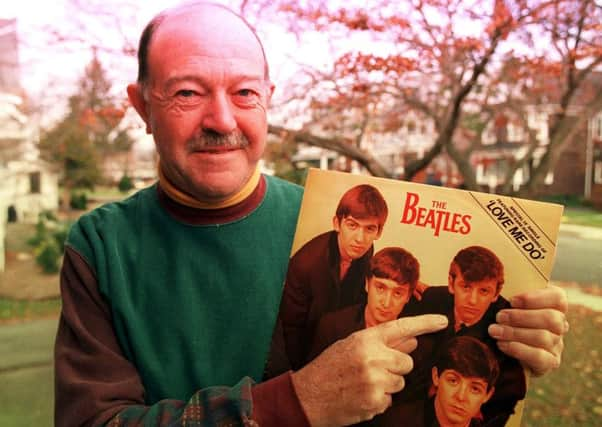Obituary: Andy White, drummer


Andy White was a drummer from Glasgow who lived most of his life in obscurity, despite a close professional proximity to many of the UK’s biggest music stars of the 1960s. In his later years, however, it was revealed that he had played a modest but significant part in the careers of the most successful group of the 20th century. Although White’s claim on the mythical, much passed-around mantle of “fifth Beatle” is tenuous – he was never a member and played with the group for only one day – the fact that he was the man who played drums on the Beatles’ debut hit Love Me Do has become common currency.
As with any historical detail of an icon as monolithic as the Beatles, however, there are levels of headline-worthy legend and forensic analysis on the part of dedicated fans to get through before such a claim stands up.
Advertisement
Hide AdAdvertisement
Hide AdThe reality is this: on 16 August, 1962, the group’s original drummer Pete Best was let go by manager Brian Epstein for what may now be termed “musical differences” with the band.
Two days earlier, John Lennon had asked their old friend Ringo Starr to join, and two days after Best’s dismissal he played his first show with the group.
One test version of Love Me Do had already been recorded with Best, on 6 June that year. On 4 September the group, with Starr, went into Abbey Road Studios for the song’s official recording session.
However, George Martin and his production team were more used to working with experienced session drummers than a then-novice like Starr. It took 15 takes to capture a version which was satisfactory to Martin, although he still had his doubts.
Deputising to his assistant Ron Richards in his own absence, the latter had one more session booked for a week later, 11 September, this time with one of Abbey Road’s regular session drummers. Andy White was the man who got the call.
Paid £5 for the session and 10/- (roughly 50 pence) for using his own drum kit, White later remembered from the three-hour morning session that it involved playing the track over and over under Lennon and Paul McCartney’s eye as they made suggestions, prior to the take. George Harrison popped in at the end of the session, but White didn’t notice Starr; the sound of the tambourine the drummer was relegated to playing is the easiest way to tell the versions apart.
In a convoluted twist to the easy credit of this song’s drum part to White, it was actually Starr’s take which was released in the UK on 5 October, and which became the group’s first hit, reaching number 17 in the charts.
Yet many of the subsequent releases used White’s version, including on the group’s debut album Please Please Me, the 1964 American release which topped the charts, and on the highly successful 1962-1966 compilation, released in 1973.
Advertisement
Hide AdAdvertisement
Hide AdIt wasn’t the only song White played with the Beatles that day. He also drummed on the first, noticeably faster version of Please Please Me (unreleased until its appearance on the Anthology 1 rarities collection in 1995) and on the only recording of PS I Love You.
This latter song, the B-side of Love Me Do and a Please Please Me album track, was the one Beatles drum part by White which was uncontestably “his’.
In 2012 a planned 50th anniversary re-release of Love Me Do was recalled when it was discovered that it was the White and not the Starr version, although White remained unconcerned about the lack of recognition.
He was later asked in an interview if the gig opened any doors for him. “I don’t think so,” he said. “Nobody was supposed to know about it.”
In the recording climate of the time, recording sessions were professional gigs for interchangeable musicians, and your wage was what you played for.
Not that White needed recognition at the time. Brought up in Shawfield, he played drums with the Boy Scouts and at holiday camps, and was taught by the then-renowned Glasgow big band drummer Lester Penman.
A swing and jazz drummer, as well as a rock ’n’ roll one, he toured the US in the 1950s with the Vic Lewis Band, appearing alongside Chuck Berry and Bill Haley & the Comets, and played on Billy Fury’s debut album The Sound of Fury (1960).
Following his day with the Beatles he also played drums on Tom Jones It’s Not Unusual and Lulu’s Shout (as fellow Scots, the pair bonded), and was a member of Marlene Dietrich’s touring band under Burt Bacharach’s musical direction.
Advertisement
Hide AdAdvertisement
Hide AdWhite spent the last few decades of his life living in New Jersey with his second wife, voice actor Thea, who he met while on tour with Dietrich.
A proud ex-pat, he played in local pipe bands, with New Jersey rockers the Smithereens on their Beatles covers album, and on stage with Rod Stewart when his tour schedule brought him to the area.
He also taught drums, to young beginners right up to Bruce Springsteen’s guitarist Steven Van Zandt, aka Silvio in the New Jersey-set gangster series The Sopranos, for his role in Sopranos creator David Chase’s film debut Not Fade Away (2012).
He was “an all round great guy and always a true gentleman,” noted one of the many condolences on the Facebook page of the New York Metro Pipe Band. “His legacy will live on forever,” said another. It deserves to; few have made a bigger ripple in pop cultural history with just one morning’s work.